Multilateral Diplomacy Essay: International Relations Analysis
VerifiedAdded on 2022/11/18
|9
|2141
|388
Essay
AI Summary
This essay delves into the concept of multilateral diplomacy, differentiating it from conference diplomacy and highlighting its significance in fostering international relations and cooperation among three or more nations. It traces the evolution of multilateral diplomacy, particularly after the two World Wars, and emphasizes its role in strengthening trade, economic, military, and environmental collaborations. The essay provides examples like the Rio Summit and the UN to illustrate its application and underscores the necessity of pre-defined rules and principles. It further examines the establishment of institutions like the UN and IMF, analyzing their objectives in promoting global peace, security, and economic stability. The essay also explores the challenges faced by these institutions, such as the influence of powerful nations and the need for effective global governance, while also touching upon supranational polities and regional bodies that contribute to multilateral diplomacy.
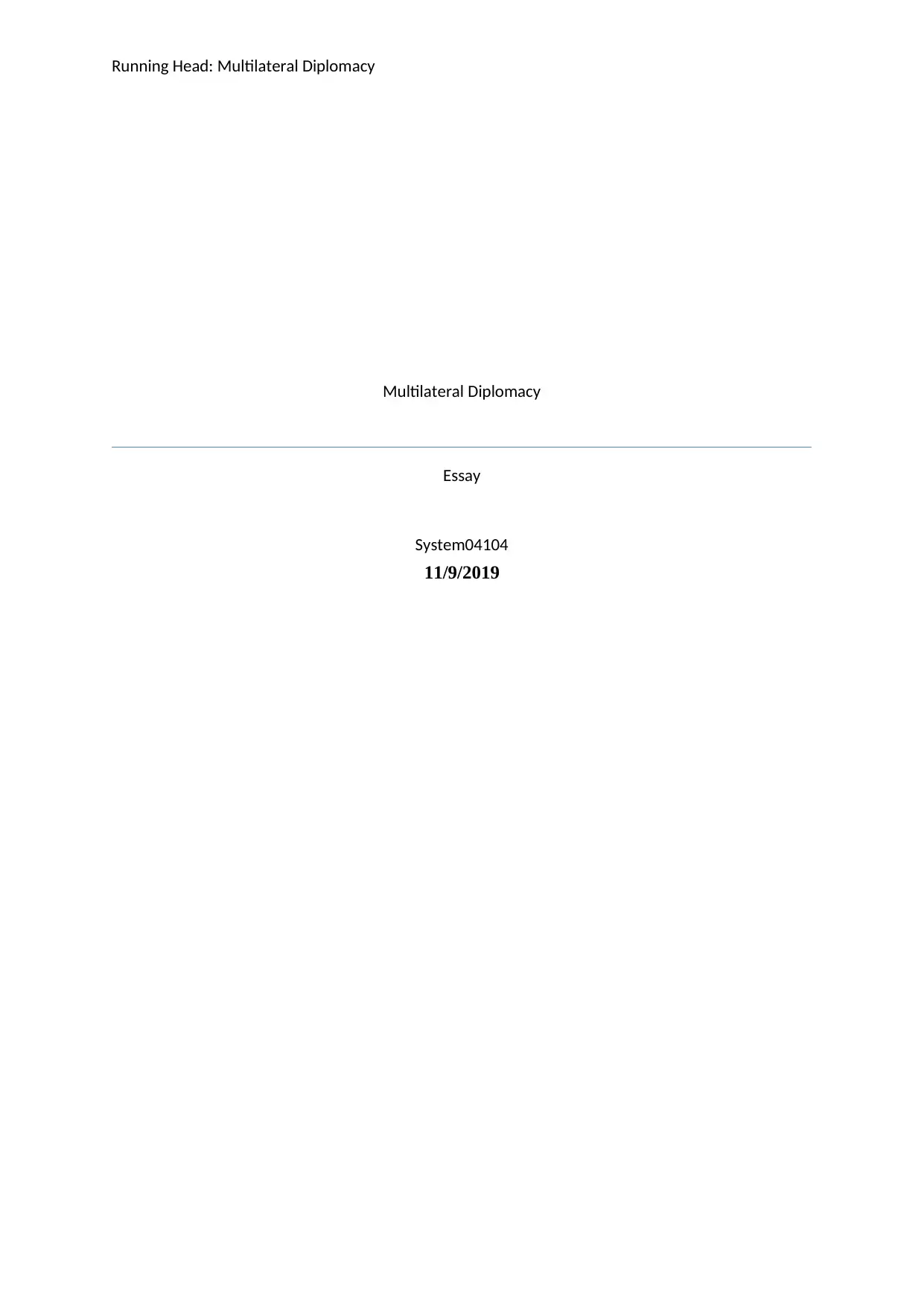
Running Head: Multilateral Diplomacy
Multilateral Diplomacy
Essay
System04104
11/9/2019
Multilateral Diplomacy
Essay
System04104
11/9/2019
Paraphrase This Document
Need a fresh take? Get an instant paraphrase of this document with our AI Paraphraser
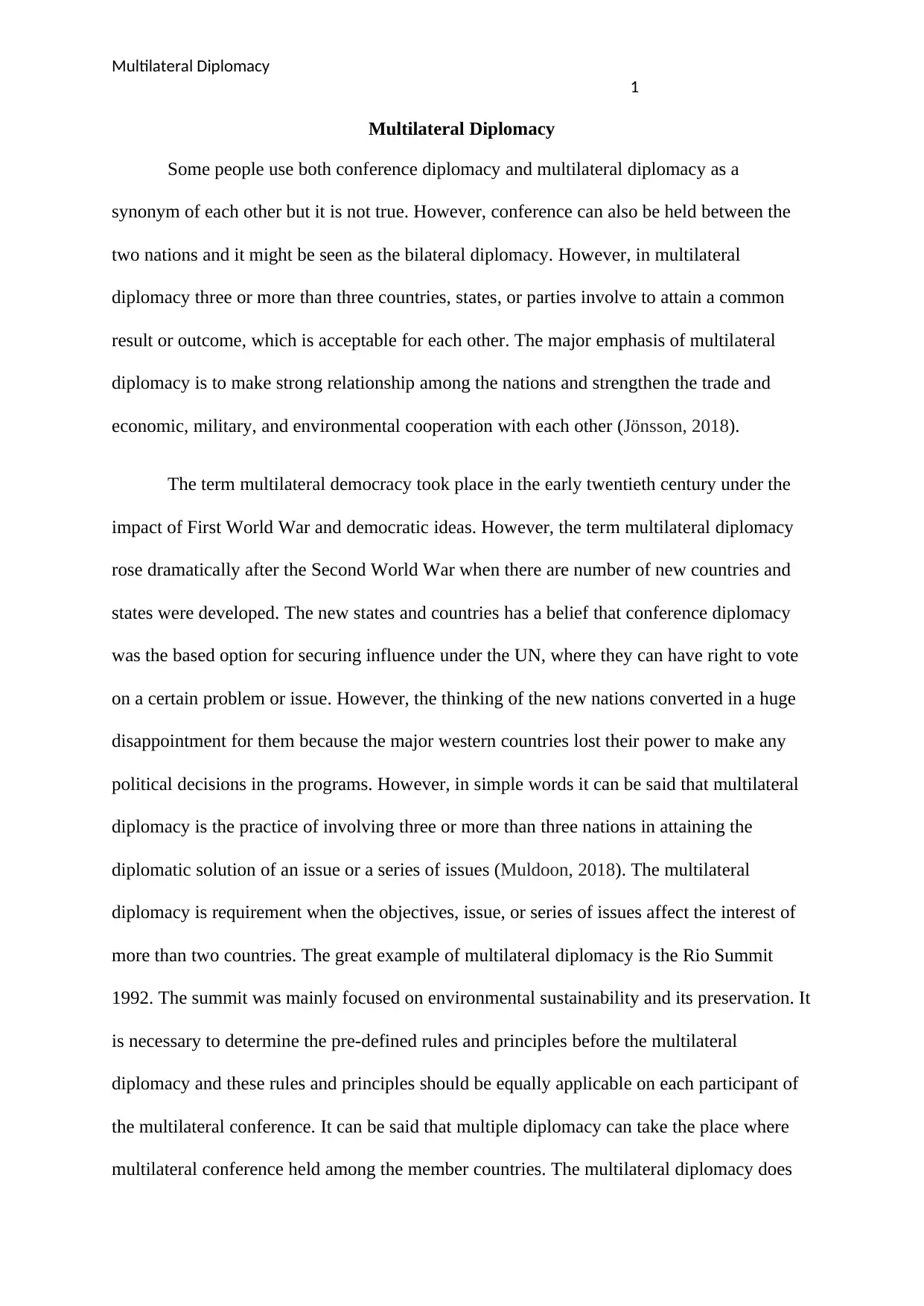
Multilateral Diplomacy
1
Multilateral Diplomacy
Some people use both conference diplomacy and multilateral diplomacy as a
synonym of each other but it is not true. However, conference can also be held between the
two nations and it might be seen as the bilateral diplomacy. However, in multilateral
diplomacy three or more than three countries, states, or parties involve to attain a common
result or outcome, which is acceptable for each other. The major emphasis of multilateral
diplomacy is to make strong relationship among the nations and strengthen the trade and
economic, military, and environmental cooperation with each other (Jönsson, 2018).
The term multilateral democracy took place in the early twentieth century under the
impact of First World War and democratic ideas. However, the term multilateral diplomacy
rose dramatically after the Second World War when there are number of new countries and
states were developed. The new states and countries has a belief that conference diplomacy
was the based option for securing influence under the UN, where they can have right to vote
on a certain problem or issue. However, the thinking of the new nations converted in a huge
disappointment for them because the major western countries lost their power to make any
political decisions in the programs. However, in simple words it can be said that multilateral
diplomacy is the practice of involving three or more than three nations in attaining the
diplomatic solution of an issue or a series of issues (Muldoon, 2018). The multilateral
diplomacy is requirement when the objectives, issue, or series of issues affect the interest of
more than two countries. The great example of multilateral diplomacy is the Rio Summit
1992. The summit was mainly focused on environmental sustainability and its preservation. It
is necessary to determine the pre-defined rules and principles before the multilateral
diplomacy and these rules and principles should be equally applicable on each participant of
the multilateral conference. It can be said that multiple diplomacy can take the place where
multilateral conference held among the member countries. The multilateral diplomacy does
1
Multilateral Diplomacy
Some people use both conference diplomacy and multilateral diplomacy as a
synonym of each other but it is not true. However, conference can also be held between the
two nations and it might be seen as the bilateral diplomacy. However, in multilateral
diplomacy three or more than three countries, states, or parties involve to attain a common
result or outcome, which is acceptable for each other. The major emphasis of multilateral
diplomacy is to make strong relationship among the nations and strengthen the trade and
economic, military, and environmental cooperation with each other (Jönsson, 2018).
The term multilateral democracy took place in the early twentieth century under the
impact of First World War and democratic ideas. However, the term multilateral diplomacy
rose dramatically after the Second World War when there are number of new countries and
states were developed. The new states and countries has a belief that conference diplomacy
was the based option for securing influence under the UN, where they can have right to vote
on a certain problem or issue. However, the thinking of the new nations converted in a huge
disappointment for them because the major western countries lost their power to make any
political decisions in the programs. However, in simple words it can be said that multilateral
diplomacy is the practice of involving three or more than three nations in attaining the
diplomatic solution of an issue or a series of issues (Muldoon, 2018). The multilateral
diplomacy is requirement when the objectives, issue, or series of issues affect the interest of
more than two countries. The great example of multilateral diplomacy is the Rio Summit
1992. The summit was mainly focused on environmental sustainability and its preservation. It
is necessary to determine the pre-defined rules and principles before the multilateral
diplomacy and these rules and principles should be equally applicable on each participant of
the multilateral conference. It can be said that multiple diplomacy can take the place where
multilateral conference held among the member countries. The multilateral diplomacy does
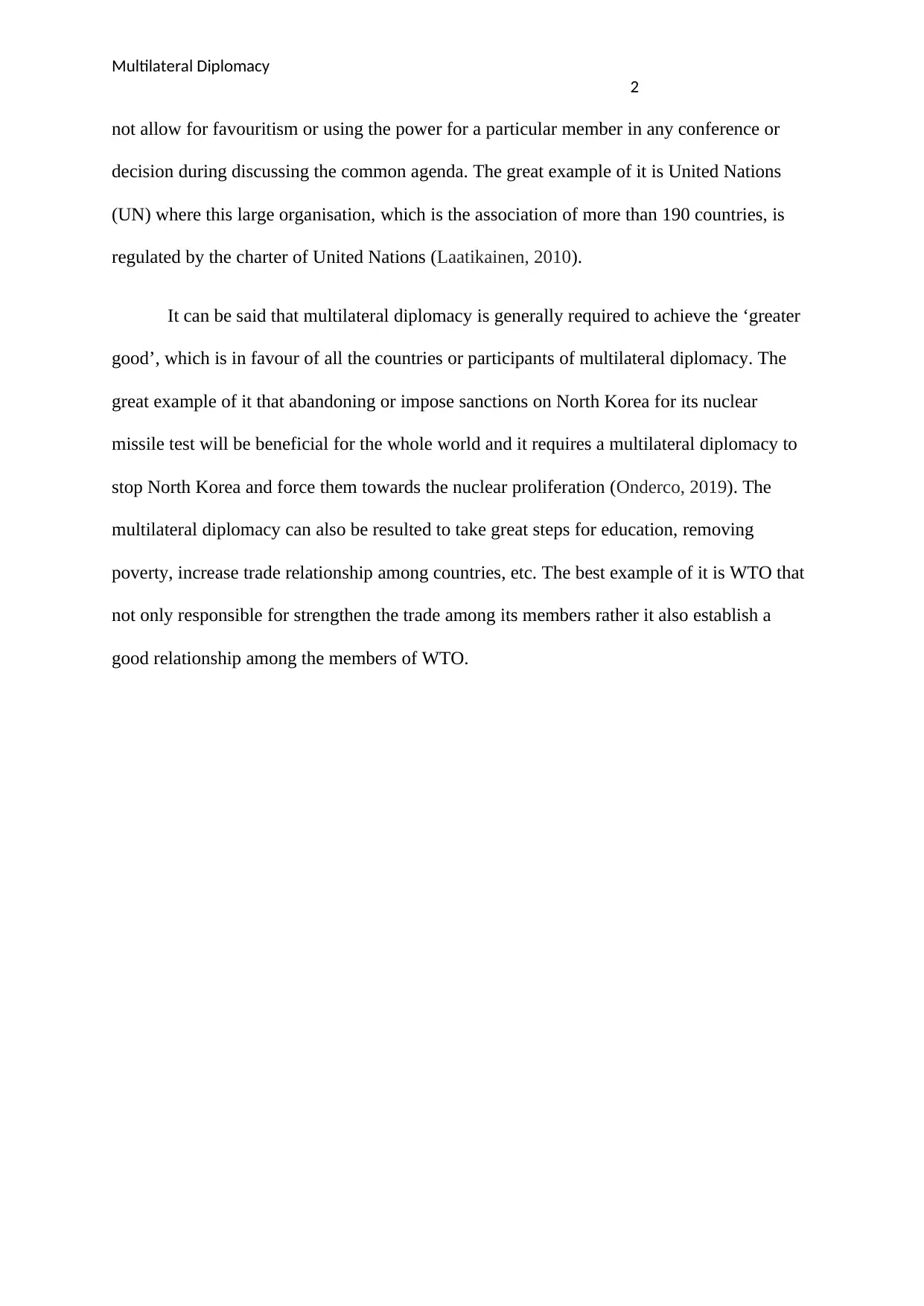
Multilateral Diplomacy
2
not allow for favouritism or using the power for a particular member in any conference or
decision during discussing the common agenda. The great example of it is United Nations
(UN) where this large organisation, which is the association of more than 190 countries, is
regulated by the charter of United Nations (Laatikainen, 2010).
It can be said that multilateral diplomacy is generally required to achieve the ‘greater
good’, which is in favour of all the countries or participants of multilateral diplomacy. The
great example of it that abandoning or impose sanctions on North Korea for its nuclear
missile test will be beneficial for the whole world and it requires a multilateral diplomacy to
stop North Korea and force them towards the nuclear proliferation (Onderco, 2019). The
multilateral diplomacy can also be resulted to take great steps for education, removing
poverty, increase trade relationship among countries, etc. The best example of it is WTO that
not only responsible for strengthen the trade among its members rather it also establish a
good relationship among the members of WTO.
2
not allow for favouritism or using the power for a particular member in any conference or
decision during discussing the common agenda. The great example of it is United Nations
(UN) where this large organisation, which is the association of more than 190 countries, is
regulated by the charter of United Nations (Laatikainen, 2010).
It can be said that multilateral diplomacy is generally required to achieve the ‘greater
good’, which is in favour of all the countries or participants of multilateral diplomacy. The
great example of it that abandoning or impose sanctions on North Korea for its nuclear
missile test will be beneficial for the whole world and it requires a multilateral diplomacy to
stop North Korea and force them towards the nuclear proliferation (Onderco, 2019). The
multilateral diplomacy can also be resulted to take great steps for education, removing
poverty, increase trade relationship among countries, etc. The best example of it is WTO that
not only responsible for strengthen the trade among its members rather it also establish a
good relationship among the members of WTO.
⊘ This is a preview!⊘
Do you want full access?
Subscribe today to unlock all pages.

Trusted by 1+ million students worldwide
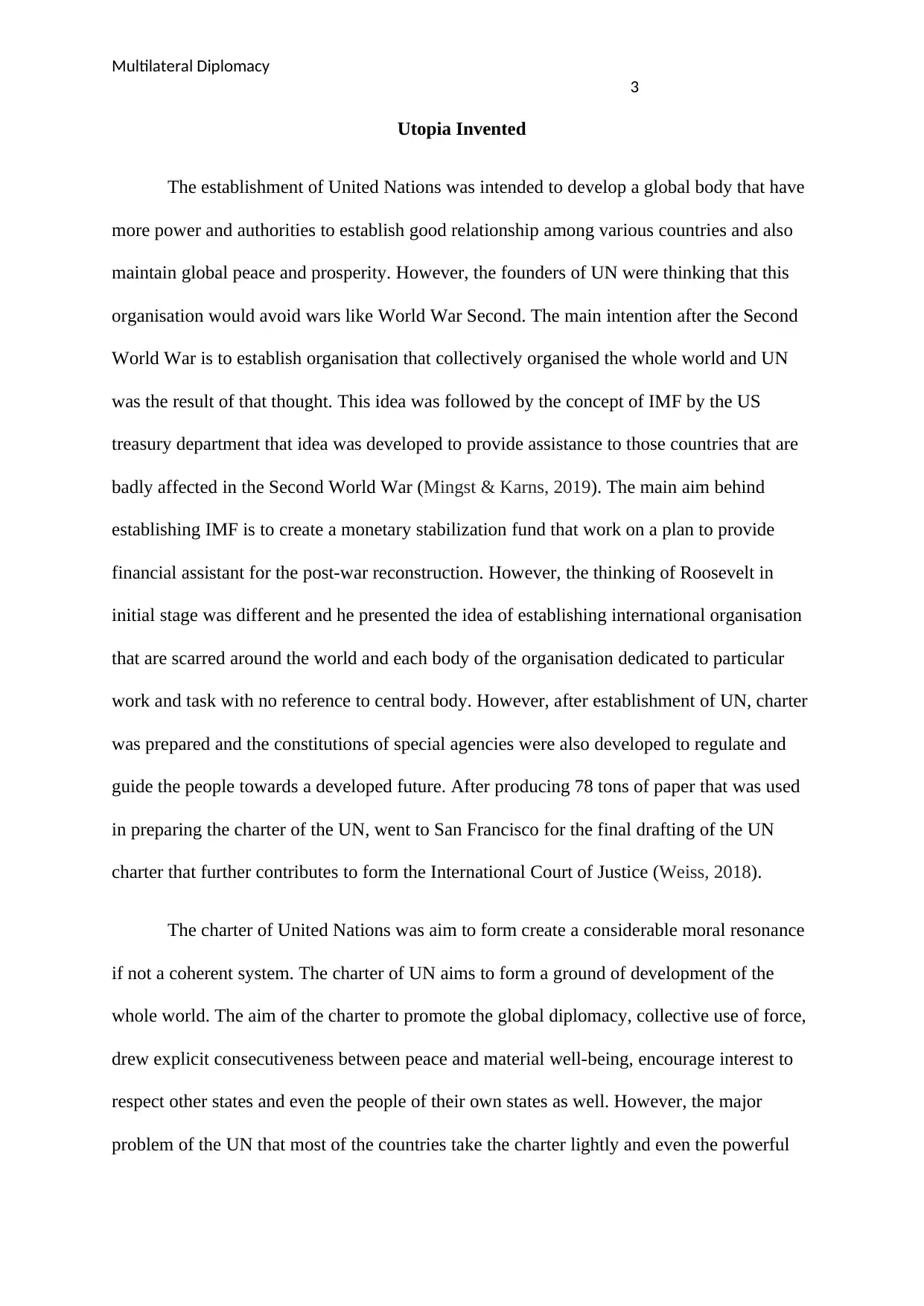
Multilateral Diplomacy
3
Utopia Invented
The establishment of United Nations was intended to develop a global body that have
more power and authorities to establish good relationship among various countries and also
maintain global peace and prosperity. However, the founders of UN were thinking that this
organisation would avoid wars like World War Second. The main intention after the Second
World War is to establish organisation that collectively organised the whole world and UN
was the result of that thought. This idea was followed by the concept of IMF by the US
treasury department that idea was developed to provide assistance to those countries that are
badly affected in the Second World War (Mingst & Karns, 2019). The main aim behind
establishing IMF is to create a monetary stabilization fund that work on a plan to provide
financial assistant for the post-war reconstruction. However, the thinking of Roosevelt in
initial stage was different and he presented the idea of establishing international organisation
that are scarred around the world and each body of the organisation dedicated to particular
work and task with no reference to central body. However, after establishment of UN, charter
was prepared and the constitutions of special agencies were also developed to regulate and
guide the people towards a developed future. After producing 78 tons of paper that was used
in preparing the charter of the UN, went to San Francisco for the final drafting of the UN
charter that further contributes to form the International Court of Justice (Weiss, 2018).
The charter of United Nations was aim to form create a considerable moral resonance
if not a coherent system. The charter of UN aims to form a ground of development of the
whole world. The aim of the charter to promote the global diplomacy, collective use of force,
drew explicit consecutiveness between peace and material well-being, encourage interest to
respect other states and even the people of their own states as well. However, the major
problem of the UN that most of the countries take the charter lightly and even the powerful
3
Utopia Invented
The establishment of United Nations was intended to develop a global body that have
more power and authorities to establish good relationship among various countries and also
maintain global peace and prosperity. However, the founders of UN were thinking that this
organisation would avoid wars like World War Second. The main intention after the Second
World War is to establish organisation that collectively organised the whole world and UN
was the result of that thought. This idea was followed by the concept of IMF by the US
treasury department that idea was developed to provide assistance to those countries that are
badly affected in the Second World War (Mingst & Karns, 2019). The main aim behind
establishing IMF is to create a monetary stabilization fund that work on a plan to provide
financial assistant for the post-war reconstruction. However, the thinking of Roosevelt in
initial stage was different and he presented the idea of establishing international organisation
that are scarred around the world and each body of the organisation dedicated to particular
work and task with no reference to central body. However, after establishment of UN, charter
was prepared and the constitutions of special agencies were also developed to regulate and
guide the people towards a developed future. After producing 78 tons of paper that was used
in preparing the charter of the UN, went to San Francisco for the final drafting of the UN
charter that further contributes to form the International Court of Justice (Weiss, 2018).
The charter of United Nations was aim to form create a considerable moral resonance
if not a coherent system. The charter of UN aims to form a ground of development of the
whole world. The aim of the charter to promote the global diplomacy, collective use of force,
drew explicit consecutiveness between peace and material well-being, encourage interest to
respect other states and even the people of their own states as well. However, the major
problem of the UN that most of the countries take the charter lightly and even the powerful
Paraphrase This Document
Need a fresh take? Get an instant paraphrase of this document with our AI Paraphraser
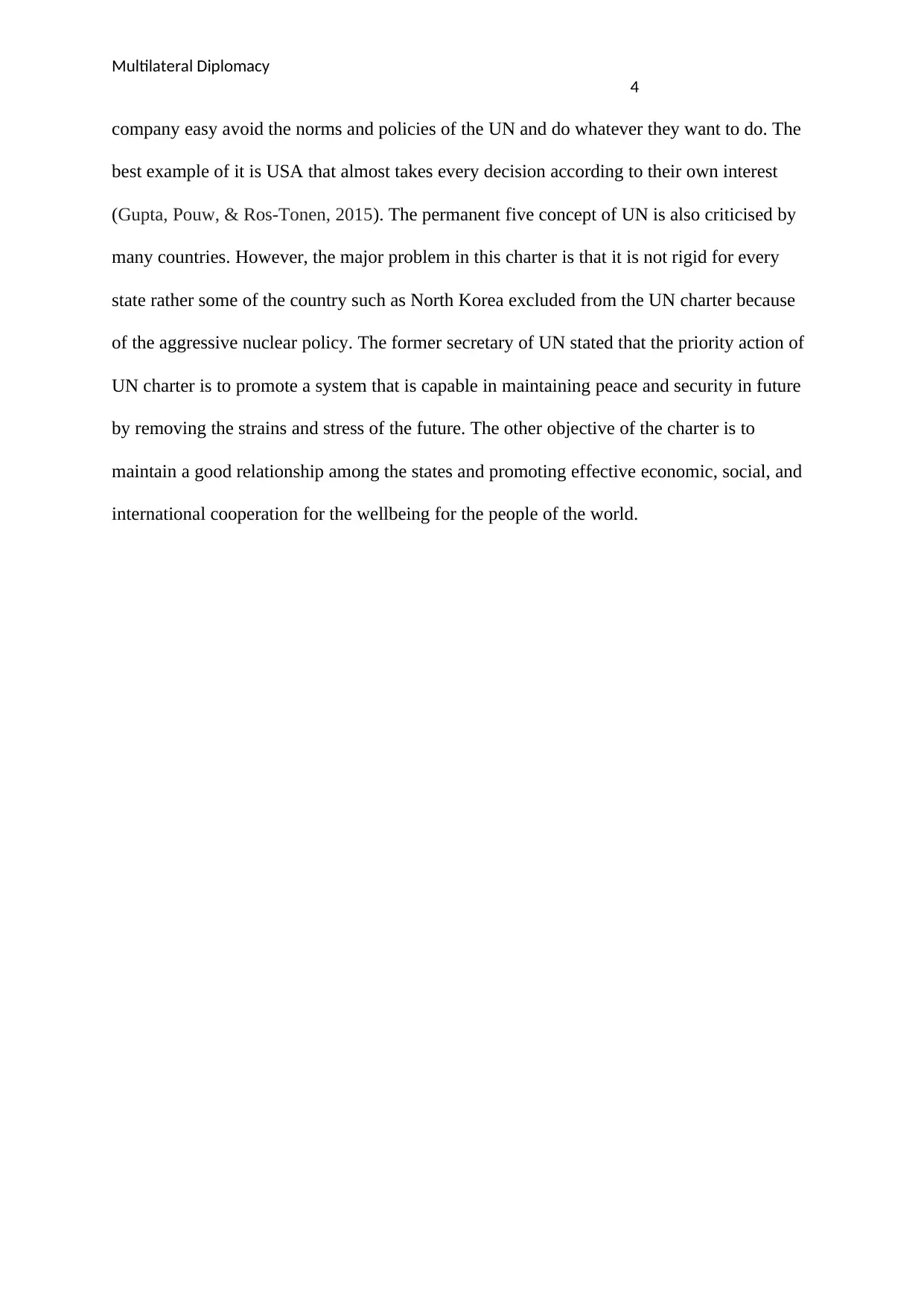
Multilateral Diplomacy
4
company easy avoid the norms and policies of the UN and do whatever they want to do. The
best example of it is USA that almost takes every decision according to their own interest
(Gupta, Pouw, & Ros-Tonen, 2015). The permanent five concept of UN is also criticised by
many countries. However, the major problem in this charter is that it is not rigid for every
state rather some of the country such as North Korea excluded from the UN charter because
of the aggressive nuclear policy. The former secretary of UN stated that the priority action of
UN charter is to promote a system that is capable in maintaining peace and security in future
by removing the strains and stress of the future. The other objective of the charter is to
maintain a good relationship among the states and promoting effective economic, social, and
international cooperation for the wellbeing for the people of the world.
4
company easy avoid the norms and policies of the UN and do whatever they want to do. The
best example of it is USA that almost takes every decision according to their own interest
(Gupta, Pouw, & Ros-Tonen, 2015). The permanent five concept of UN is also criticised by
many countries. However, the major problem in this charter is that it is not rigid for every
state rather some of the country such as North Korea excluded from the UN charter because
of the aggressive nuclear policy. The former secretary of UN stated that the priority action of
UN charter is to promote a system that is capable in maintaining peace and security in future
by removing the strains and stress of the future. The other objective of the charter is to
maintain a good relationship among the states and promoting effective economic, social, and
international cooperation for the wellbeing for the people of the world.
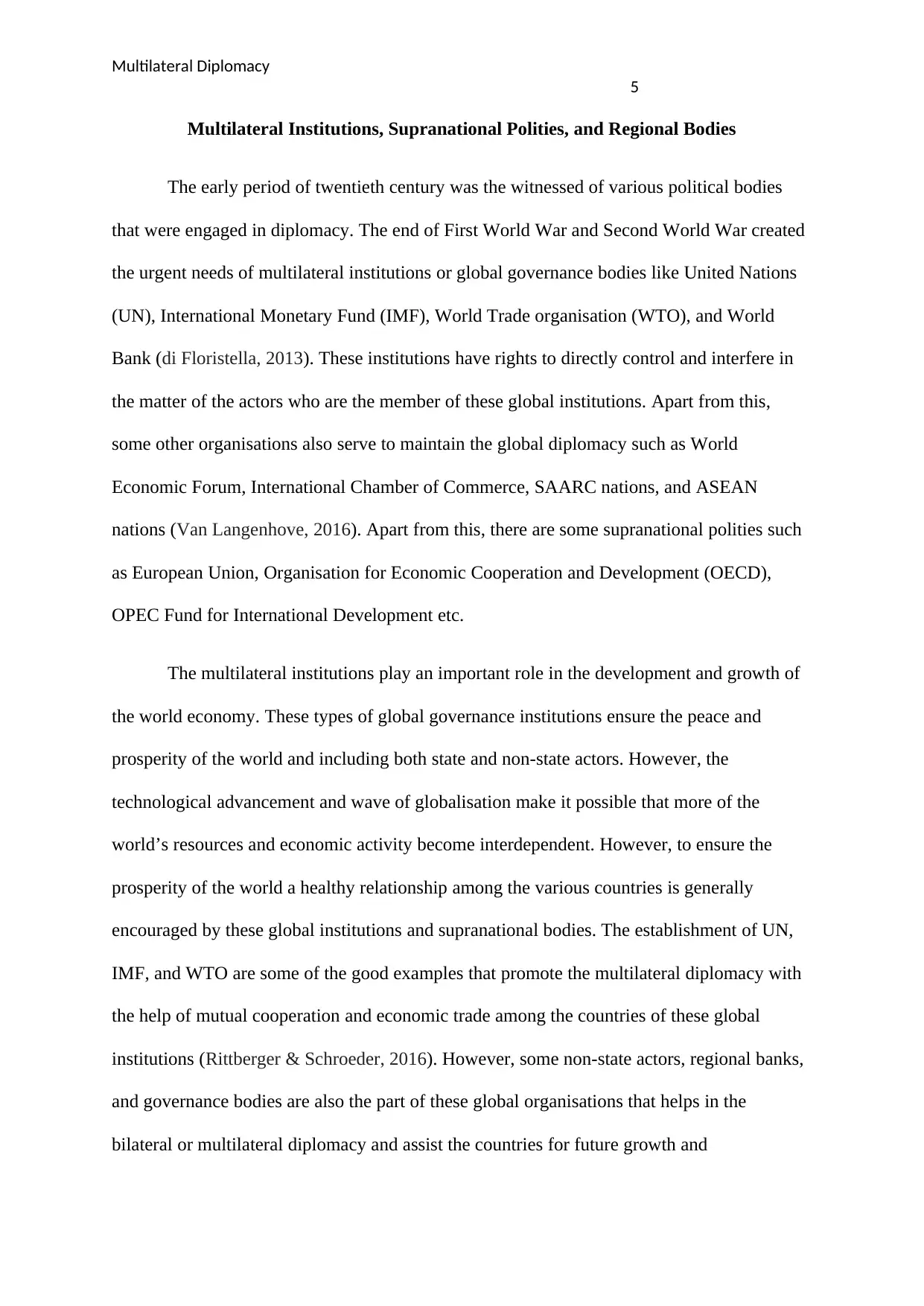
Multilateral Diplomacy
5
Multilateral Institutions, Supranational Polities, and Regional Bodies
The early period of twentieth century was the witnessed of various political bodies
that were engaged in diplomacy. The end of First World War and Second World War created
the urgent needs of multilateral institutions or global governance bodies like United Nations
(UN), International Monetary Fund (IMF), World Trade organisation (WTO), and World
Bank (di Floristella, 2013). These institutions have rights to directly control and interfere in
the matter of the actors who are the member of these global institutions. Apart from this,
some other organisations also serve to maintain the global diplomacy such as World
Economic Forum, International Chamber of Commerce, SAARC nations, and ASEAN
nations (Van Langenhove, 2016). Apart from this, there are some supranational polities such
as European Union, Organisation for Economic Cooperation and Development (OECD),
OPEC Fund for International Development etc.
The multilateral institutions play an important role in the development and growth of
the world economy. These types of global governance institutions ensure the peace and
prosperity of the world and including both state and non-state actors. However, the
technological advancement and wave of globalisation make it possible that more of the
world’s resources and economic activity become interdependent. However, to ensure the
prosperity of the world a healthy relationship among the various countries is generally
encouraged by these global institutions and supranational bodies. The establishment of UN,
IMF, and WTO are some of the good examples that promote the multilateral diplomacy with
the help of mutual cooperation and economic trade among the countries of these global
institutions (Rittberger & Schroeder, 2016). However, some non-state actors, regional banks,
and governance bodies are also the part of these global organisations that helps in the
bilateral or multilateral diplomacy and assist the countries for future growth and
5
Multilateral Institutions, Supranational Polities, and Regional Bodies
The early period of twentieth century was the witnessed of various political bodies
that were engaged in diplomacy. The end of First World War and Second World War created
the urgent needs of multilateral institutions or global governance bodies like United Nations
(UN), International Monetary Fund (IMF), World Trade organisation (WTO), and World
Bank (di Floristella, 2013). These institutions have rights to directly control and interfere in
the matter of the actors who are the member of these global institutions. Apart from this,
some other organisations also serve to maintain the global diplomacy such as World
Economic Forum, International Chamber of Commerce, SAARC nations, and ASEAN
nations (Van Langenhove, 2016). Apart from this, there are some supranational polities such
as European Union, Organisation for Economic Cooperation and Development (OECD),
OPEC Fund for International Development etc.
The multilateral institutions play an important role in the development and growth of
the world economy. These types of global governance institutions ensure the peace and
prosperity of the world and including both state and non-state actors. However, the
technological advancement and wave of globalisation make it possible that more of the
world’s resources and economic activity become interdependent. However, to ensure the
prosperity of the world a healthy relationship among the various countries is generally
encouraged by these global institutions and supranational bodies. The establishment of UN,
IMF, and WTO are some of the good examples that promote the multilateral diplomacy with
the help of mutual cooperation and economic trade among the countries of these global
institutions (Rittberger & Schroeder, 2016). However, some non-state actors, regional banks,
and governance bodies are also the part of these global organisations that helps in the
bilateral or multilateral diplomacy and assist the countries for future growth and
⊘ This is a preview!⊘
Do you want full access?
Subscribe today to unlock all pages.

Trusted by 1+ million students worldwide
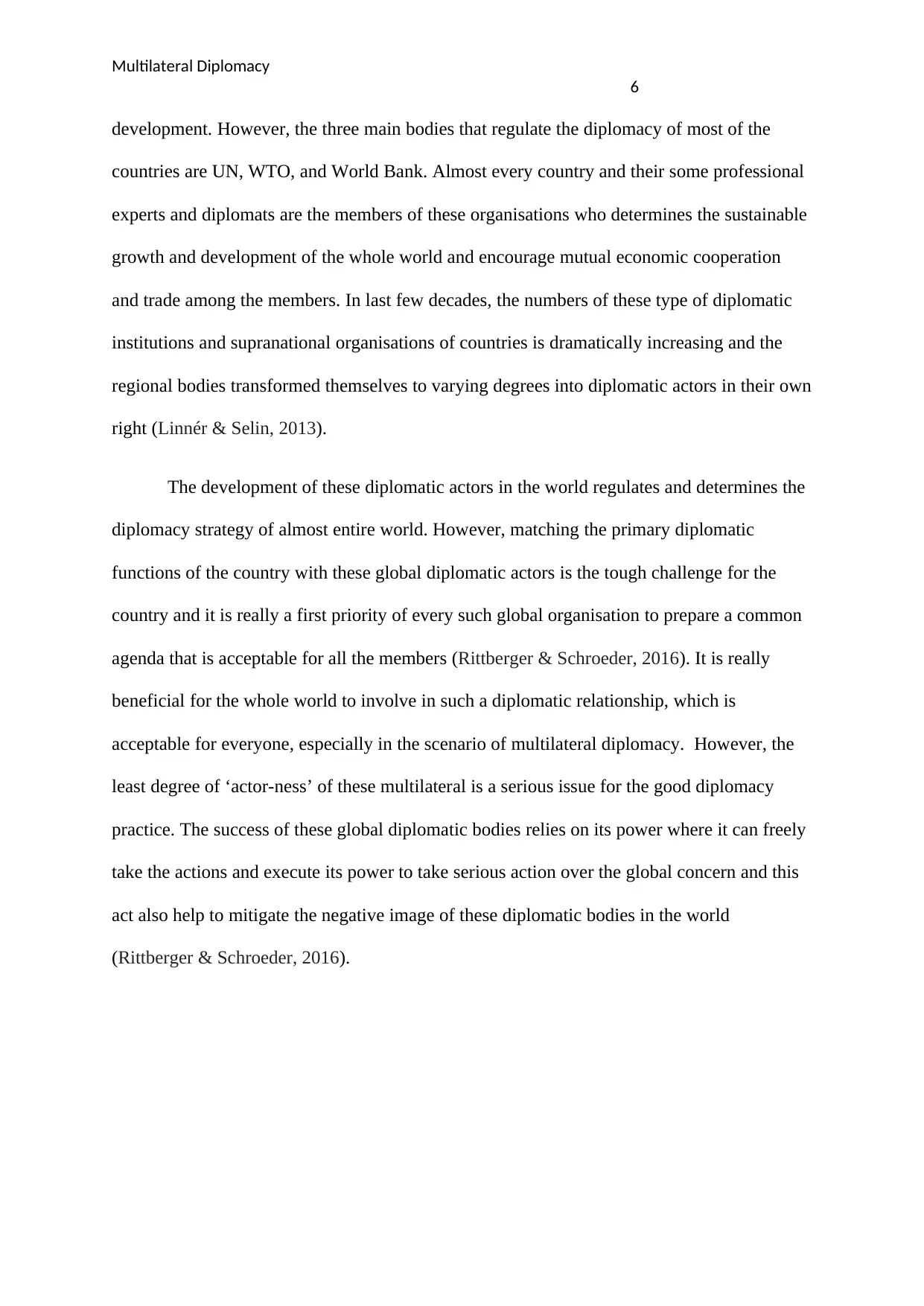
Multilateral Diplomacy
6
development. However, the three main bodies that regulate the diplomacy of most of the
countries are UN, WTO, and World Bank. Almost every country and their some professional
experts and diplomats are the members of these organisations who determines the sustainable
growth and development of the whole world and encourage mutual economic cooperation
and trade among the members. In last few decades, the numbers of these type of diplomatic
institutions and supranational organisations of countries is dramatically increasing and the
regional bodies transformed themselves to varying degrees into diplomatic actors in their own
right (Linnér & Selin, 2013).
The development of these diplomatic actors in the world regulates and determines the
diplomacy strategy of almost entire world. However, matching the primary diplomatic
functions of the country with these global diplomatic actors is the tough challenge for the
country and it is really a first priority of every such global organisation to prepare a common
agenda that is acceptable for all the members (Rittberger & Schroeder, 2016). It is really
beneficial for the whole world to involve in such a diplomatic relationship, which is
acceptable for everyone, especially in the scenario of multilateral diplomacy. However, the
least degree of ‘actor-ness’ of these multilateral is a serious issue for the good diplomacy
practice. The success of these global diplomatic bodies relies on its power where it can freely
take the actions and execute its power to take serious action over the global concern and this
act also help to mitigate the negative image of these diplomatic bodies in the world
(Rittberger & Schroeder, 2016).
6
development. However, the three main bodies that regulate the diplomacy of most of the
countries are UN, WTO, and World Bank. Almost every country and their some professional
experts and diplomats are the members of these organisations who determines the sustainable
growth and development of the whole world and encourage mutual economic cooperation
and trade among the members. In last few decades, the numbers of these type of diplomatic
institutions and supranational organisations of countries is dramatically increasing and the
regional bodies transformed themselves to varying degrees into diplomatic actors in their own
right (Linnér & Selin, 2013).
The development of these diplomatic actors in the world regulates and determines the
diplomacy strategy of almost entire world. However, matching the primary diplomatic
functions of the country with these global diplomatic actors is the tough challenge for the
country and it is really a first priority of every such global organisation to prepare a common
agenda that is acceptable for all the members (Rittberger & Schroeder, 2016). It is really
beneficial for the whole world to involve in such a diplomatic relationship, which is
acceptable for everyone, especially in the scenario of multilateral diplomacy. However, the
least degree of ‘actor-ness’ of these multilateral is a serious issue for the good diplomacy
practice. The success of these global diplomatic bodies relies on its power where it can freely
take the actions and execute its power to take serious action over the global concern and this
act also help to mitigate the negative image of these diplomatic bodies in the world
(Rittberger & Schroeder, 2016).
Paraphrase This Document
Need a fresh take? Get an instant paraphrase of this document with our AI Paraphraser
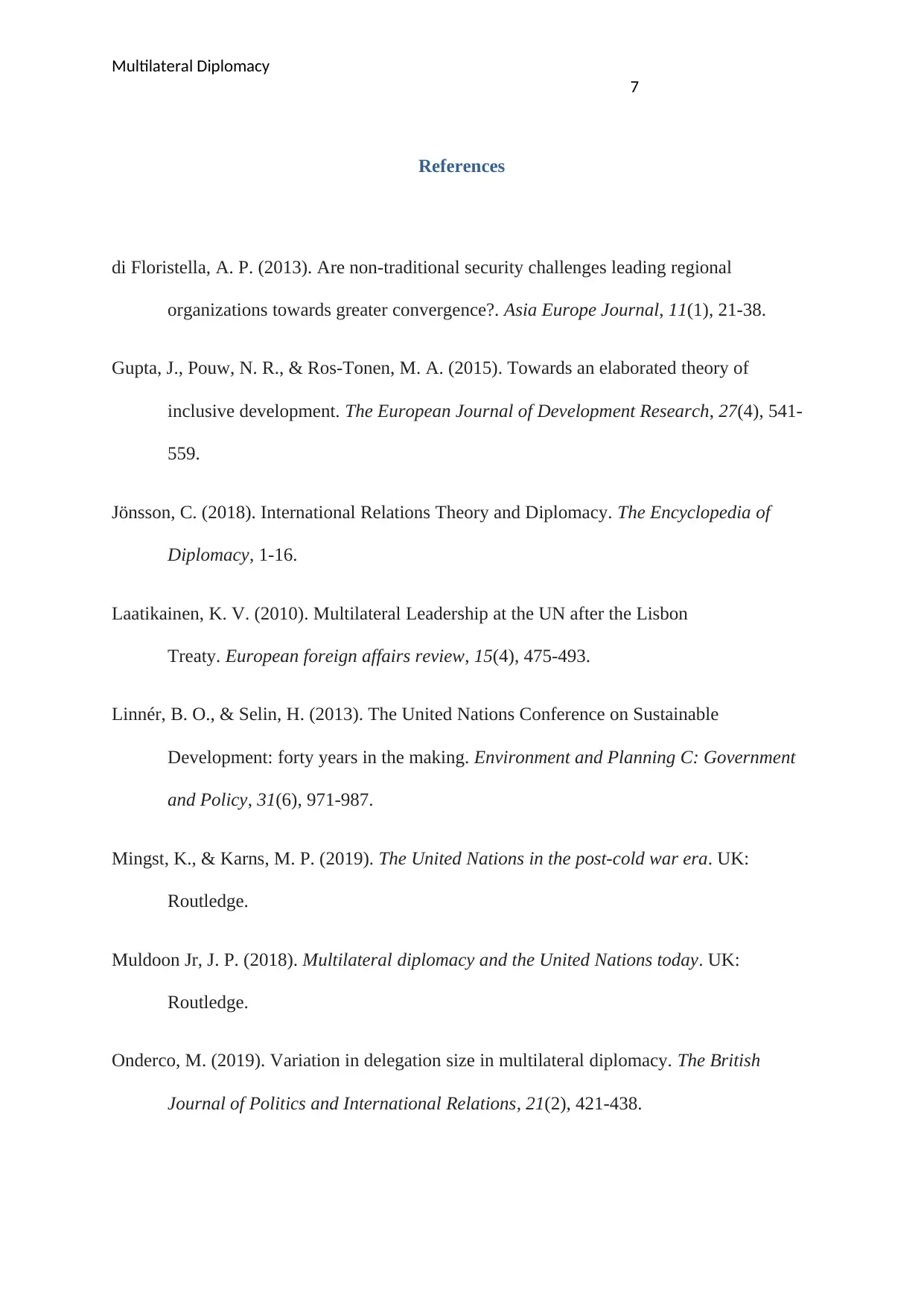
Multilateral Diplomacy
7
References
di Floristella, A. P. (2013). Are non-traditional security challenges leading regional
organizations towards greater convergence?. Asia Europe Journal, 11(1), 21-38.
Gupta, J., Pouw, N. R., & Ros-Tonen, M. A. (2015). Towards an elaborated theory of
inclusive development. The European Journal of Development Research, 27(4), 541-
559.
Jönsson, C. (2018). International Relations Theory and Diplomacy. The Encyclopedia of
Diplomacy, 1-16.
Laatikainen, K. V. (2010). Multilateral Leadership at the UN after the Lisbon
Treaty. European foreign affairs review, 15(4), 475-493.
Linnér, B. O., & Selin, H. (2013). The United Nations Conference on Sustainable
Development: forty years in the making. Environment and Planning C: Government
and Policy, 31(6), 971-987.
Mingst, K., & Karns, M. P. (2019). The United Nations in the post-cold war era. UK:
Routledge.
Muldoon Jr, J. P. (2018). Multilateral diplomacy and the United Nations today. UK:
Routledge.
Onderco, M. (2019). Variation in delegation size in multilateral diplomacy. The British
Journal of Politics and International Relations, 21(2), 421-438.
7
References
di Floristella, A. P. (2013). Are non-traditional security challenges leading regional
organizations towards greater convergence?. Asia Europe Journal, 11(1), 21-38.
Gupta, J., Pouw, N. R., & Ros-Tonen, M. A. (2015). Towards an elaborated theory of
inclusive development. The European Journal of Development Research, 27(4), 541-
559.
Jönsson, C. (2018). International Relations Theory and Diplomacy. The Encyclopedia of
Diplomacy, 1-16.
Laatikainen, K. V. (2010). Multilateral Leadership at the UN after the Lisbon
Treaty. European foreign affairs review, 15(4), 475-493.
Linnér, B. O., & Selin, H. (2013). The United Nations Conference on Sustainable
Development: forty years in the making. Environment and Planning C: Government
and Policy, 31(6), 971-987.
Mingst, K., & Karns, M. P. (2019). The United Nations in the post-cold war era. UK:
Routledge.
Muldoon Jr, J. P. (2018). Multilateral diplomacy and the United Nations today. UK:
Routledge.
Onderco, M. (2019). Variation in delegation size in multilateral diplomacy. The British
Journal of Politics and International Relations, 21(2), 421-438.
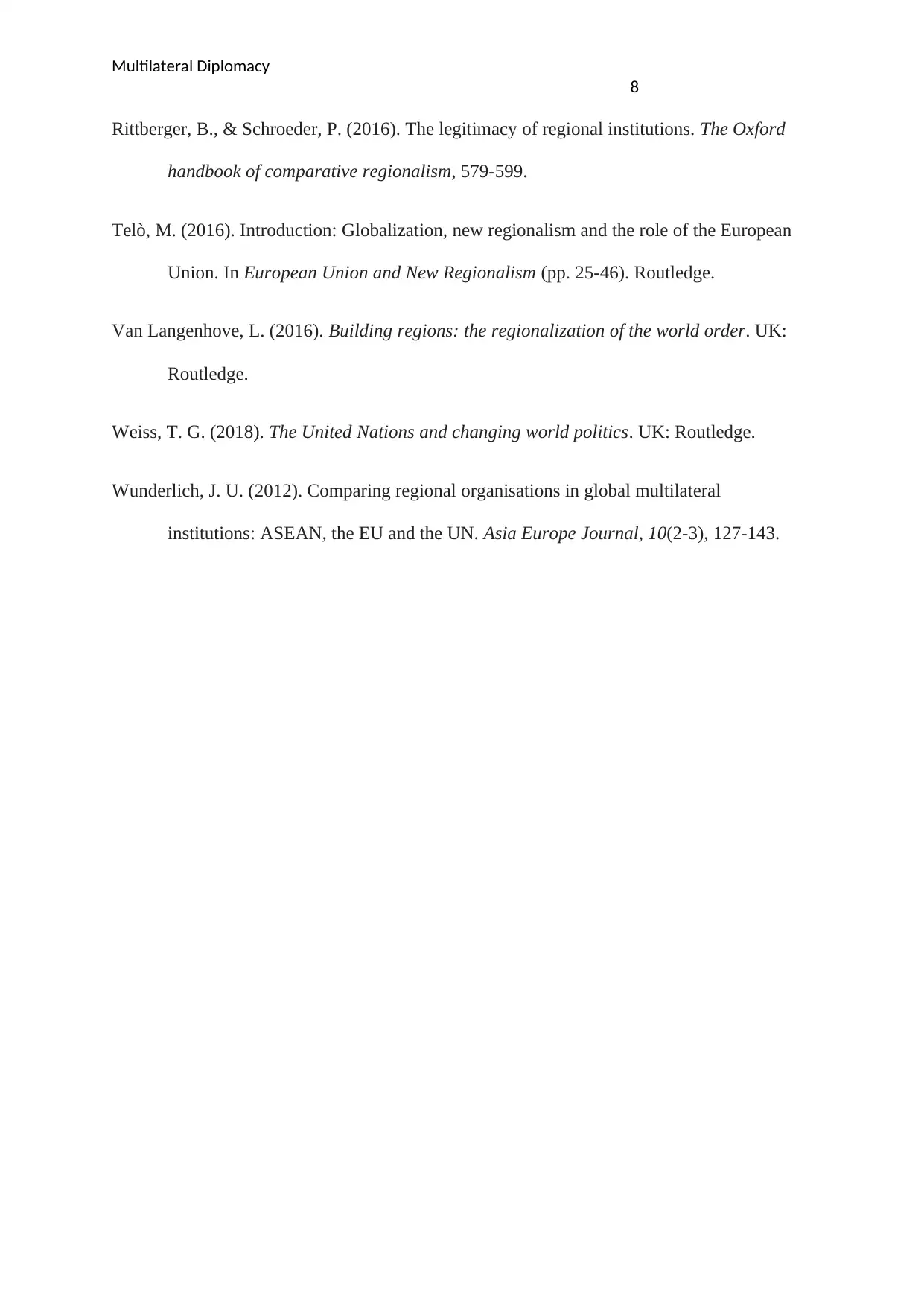
Multilateral Diplomacy
8
Rittberger, B., & Schroeder, P. (2016). The legitimacy of regional institutions. The Oxford
handbook of comparative regionalism, 579-599.
Telò, M. (2016). Introduction: Globalization, new regionalism and the role of the European
Union. In European Union and New Regionalism (pp. 25-46). Routledge.
Van Langenhove, L. (2016). Building regions: the regionalization of the world order. UK:
Routledge.
Weiss, T. G. (2018). The United Nations and changing world politics. UK: Routledge.
Wunderlich, J. U. (2012). Comparing regional organisations in global multilateral
institutions: ASEAN, the EU and the UN. Asia Europe Journal, 10(2-3), 127-143.
8
Rittberger, B., & Schroeder, P. (2016). The legitimacy of regional institutions. The Oxford
handbook of comparative regionalism, 579-599.
Telò, M. (2016). Introduction: Globalization, new regionalism and the role of the European
Union. In European Union and New Regionalism (pp. 25-46). Routledge.
Van Langenhove, L. (2016). Building regions: the regionalization of the world order. UK:
Routledge.
Weiss, T. G. (2018). The United Nations and changing world politics. UK: Routledge.
Wunderlich, J. U. (2012). Comparing regional organisations in global multilateral
institutions: ASEAN, the EU and the UN. Asia Europe Journal, 10(2-3), 127-143.
⊘ This is a preview!⊘
Do you want full access?
Subscribe today to unlock all pages.

Trusted by 1+ million students worldwide
1 out of 9
Related Documents
Your All-in-One AI-Powered Toolkit for Academic Success.
+13062052269
info@desklib.com
Available 24*7 on WhatsApp / Email
![[object Object]](/_next/static/media/star-bottom.7253800d.svg)
Unlock your academic potential
Copyright © 2020–2025 A2Z Services. All Rights Reserved. Developed and managed by ZUCOL.





